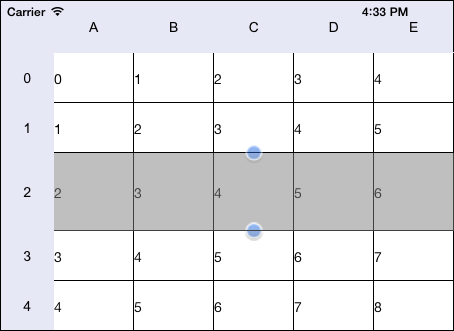
Operating system requirements: iOS 5.0 or later.
Mobile device: iPad.
This example implements changing of selected table cell height.
Executing the example requires to place the following code instead of the executeExample method of the ViewController class (see the Creating a Simple Data Grid section):
-(void) executeExample{
// Create an table resize element
NuGridResizer *resizer = [NuGridResizer resizerForGridView:[contr gridView]];
// Set parent table
[resizer setParentGrid: [contr gridView]];
// Resize vertical area used for resizing
CGSize size = CGSizeMake(90, 90);
[resizer setTopBottomSelectionTouchAreaSize:size];
// Set resize element
[[contr gridView] setValue:resizer forKey:@"m_resizer"];
// Set start size of changed cell height
rowHeight = 50;
};
// Handle table cell press event
- (void)gridView:(NuGridView *)gridView wasTouchedInCell:(NuGridCell *)cell {
// Start to change cell height
[gridView addSubview:[gridView resizer]];
[[gridView resizer] resizeHeightForCell: cell];
}
// Handle cell height change event
- (void)gridView:(NuGridView *)gridView heightChangeNeeded:(double)newHeight forCell:(NuGridCell *)cell
{
// Finish cell resizing if its height exceeds 300 pixels
if(newHeight > 300)
{
[[gridView resizer] finish];
}
// Save cell height value
rowHeight = newHeight;
// Stretch resize area after it was changed
[[gridView resizer] stretchAfterChanging];
}
It is also required to place the following code instead of the heightForRow method of the ViewController class:
// Set row height
- (double) gridView:(NuGridView *)gridView heightForRow:(NSInteger)rowNumber
{
if(rowNumber == 2)
{
return rowHeight;
}
else
{
return 50;
}
}
Press any table cell, which is in the row with the number 2, after that change its height by dragging the marker.
As a result, the selected cell height is changed:

See also: